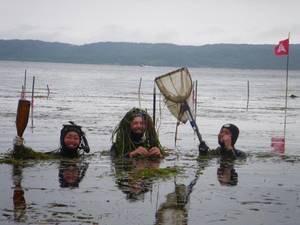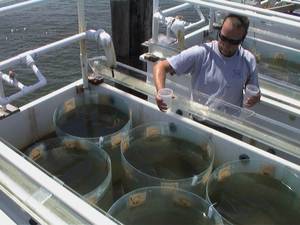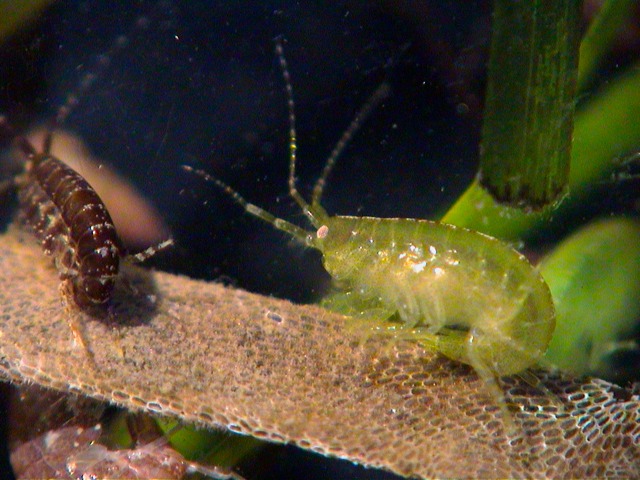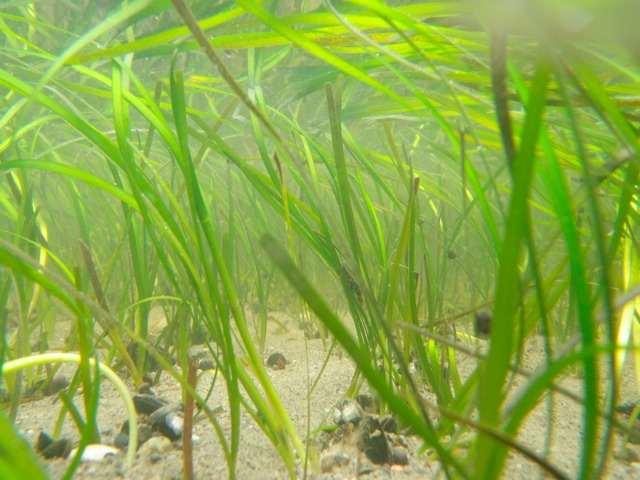Studying seagrasses: from plastic bucket to planet
Interview with
 Emmett: Seagrasses face a lot of the same threats that many other ocean habitats do. On a local level they're threatened by nutrient pollution, runoff from land, farms in domestic regions, which causes algae to overgrow them, and also soil erosion which causes the water to be turbid and dirty. Seagrasses are plants, of course, so they need a lot of light and they need clear water to grow.
Emmett: Seagrasses face a lot of the same threats that many other ocean habitats do. On a local level they're threatened by nutrient pollution, runoff from land, farms in domestic regions, which causes algae to overgrow them, and also soil erosion which causes the water to be turbid and dirty. Seagrasses are plants, of course, so they need a lot of light and they need clear water to grow.
On a global scale seagrasses are threatened by climate change as well. Like corals, they tend to be at least in temperate areas like N America and Europe, they tend to be living near their upper thermal tolerances, meaning that a little bit of a rise in temperature can push them over a tipping point. And we're beginning to see that both in the Chesapeake Bay here in the US, as well as in the Mediterranean.
Sarah: What would it mean if we started to loose these beds? Are we already seeing a decline?
Emmett: Yes, there's been quite a large decline in the coverage of seagrass over the last several decades. In the US for example I think that it's estimated that something like 70% of the seagrass coverage has been lost. And that's a problem for a number of reasons. You can think of an analogy with grasslands on land, the grass holds the soil together, it helps build soil, it obviously supports livestock that graze on it and all kinds of animals.
It's actually quite similar in the sea. The seagrasses bind sediments together and help store organic matter, they can sequester carbon out of organic matter in the water column. They provide direct food for large animals like turtles and manatees and dugongs, but probably even more importantly the grasses and the algae that are growing on them provide a lot of food and habitat for all kinds of small invertebrates that are near the base of the food change. So many fishes and shellfish use seagrass beds as nursery areas.
There are a number of commercial fisheries that depend on seagrass beds because the baby fish live in the seagrass beds and that's an important part of their life history.
Sarah: It can be quite tough to go and experiment and have a look at this kind of ecosystem in the wild, so I understand you've done a lot of 'mesocosm' experiments. How do you go about studying an ecosystem in the lab?
 Emmett: The mesocosm is the geekish word we use for trying to recreate a small version of an ecosystem. The problem that we face is that the major herbivores, the animals that eat the plants and start the process of energy flow up the food chain in seagrass beds those animals are primarily really small invertebrates, sea bugs if you will, these are little crustaceans. It's very difficult to manipulate them in the field to try and find out what they're doing.
Emmett: The mesocosm is the geekish word we use for trying to recreate a small version of an ecosystem. The problem that we face is that the major herbivores, the animals that eat the plants and start the process of energy flow up the food chain in seagrass beds those animals are primarily really small invertebrates, sea bugs if you will, these are little crustaceans. It's very difficult to manipulate them in the field to try and find out what they're doing.
So what we've done is to bring the ecosystem into the lab, not strictly the lab, but outdoor tanks, where we've planted seagrass and we have sea water flowing through them. And we've been able to put different kinds of animals into these grass beds to see what effect they have on the grass.
I mentioned earlier that the grass in important to the animals because it provides habitat. It's also true that some of these small animals are important to the grass. So it's what you might call a mutualistic interaction - you scratch my back, I'll scratch yours.
The way it works it that the seagrasses can be overgrown by nuisance algae, pond scum for example, that are superior competitors except that these small crustaceans eat that algae and therefore create conditions that are favourable for the grass. That's the kind of thing that we've been trying to figure out using the mesocosms that's very difficult to do in the field.
Sarah: And you've also received a grant to move that out into the real ecosystems. How do you go about moving your experiments from something like these fairly controlled conditions out into something where you don't necessarily have a lot of control over the variables.
Emmett: There are different questions that one can ask under those different  circumstances. So in the mesocosm experiments we've been able to look in a lot of detail under highly controlled conditions at what different species are doing, manipulated the number of species of small animals to ask whether diversity makes a difference, does it matter if you have one kind of grazer or 5 or 6 kinds of grazers. That's much more difficult to do out in the real world. So there's that disadvantage. But of course the real world is what we really want to know about.
circumstances. So in the mesocosm experiments we've been able to look in a lot of detail under highly controlled conditions at what different species are doing, manipulated the number of species of small animals to ask whether diversity makes a difference, does it matter if you have one kind of grazer or 5 or 6 kinds of grazers. That's much more difficult to do out in the real world. So there's that disadvantage. But of course the real world is what we really want to know about.
So what we've been able to do is to set up simpler experiments out there where we simply get rid of all grazers, all of these small invertebrates to find out whether that has an influence on the grass. We've done that with a degradable insecticide that is put into a slow release plaster block, so we can see what impact that has on the plants.
But is doesn't have all of the problems associated with putting a cage out in the field because cages can shade the grass and they attract fouling organisms, and sediment and all kind of stuff.
So the questions are somewhat simpler, but of course because they're done out in the actual seagrass beds with all the other forces happening in nature we get a more accurate estimate of what the effects of those grazers might be.
So we've run the same experiment at 15 different sites worldwide from Japan through both coasts of North America to Scandinavia and Portugal. And we find that there's quite a bit of variability. So in the coming year we're hoping to try and figure out why that is and part of it has to do with seasonality that there's some times of year when the grazers are active and algae growth is strong and others when that's not the case. And also there's of course geographic variation in what factors are most important.
Sarah: And how do you see these results being used going forward? Can we use them to perhaps direct conservation efforts?
 Emmett: Well I hope so. It'll certainly be important to know what the major factors influencing seagrass ecology and populations are. A lot of the work that we've done in seagrasses is uncovering the importance of some of these really small inconspicuous marine animals that nobody ever thinks about, the bugs and slugs if you will.
Emmett: Well I hope so. It'll certainly be important to know what the major factors influencing seagrass ecology and populations are. A lot of the work that we've done in seagrasses is uncovering the importance of some of these really small inconspicuous marine animals that nobody ever thinks about, the bugs and slugs if you will.
Some years ago the famous biologist EO Wilson said that insects are the little things that run the world because they're very important in terms of nutrient cycling and maintaining the structure of plant communities.
And I think what we're beginning to find out with some of this work is that the same thing is true in the oceans that some of these tiny marine animals that no one pays attention to can have very large impacts on systems that are important to maintaining it in working order.
We all love whales and turtles and so on but we also need to love the bugs and slugs.
 Find out more:
Find out more:
ZEN (The Zostera Experimental Network)
Marine Biodiversity Lab, VIMS
- Previous New Ways to Monitor Diabetes
- Next The Magnetic Moon









Comments
Add a comment